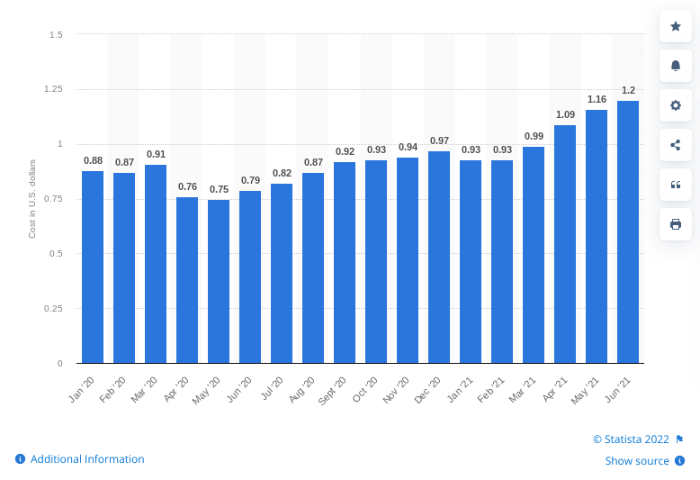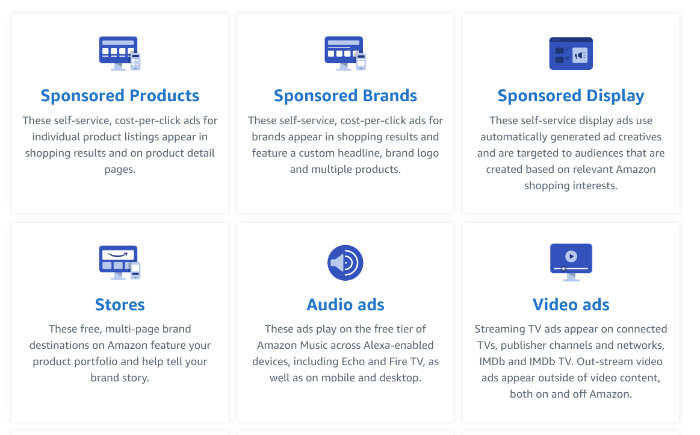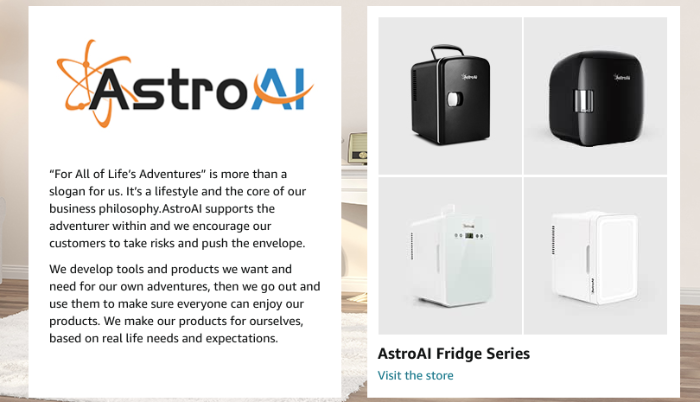Do you want to be more successful with Amazon advertising?
With millions of active customers, Amazon is the perfect place to grow your business. However, it’s not as simple as putting up products and waiting for sales to come in.
Sometimes, you may need the help of ads. Let’s take a look at how best to use them.
What Is Amazon Advertising?
Amazon advertising is paid advertising that runs on a pay-per-click model. Through them, you can feature your product listing at the top of Amazon’s search results for chosen keywords.
Rather than paying upfront for your advertising, pay-per-click ads mean you only pay when someone clicks to view your product.
PPC is very efficient because you only have to pay when you know you’ve reached your target audience. It’s still up to you to get the conversion and sell your product, but Amazon advertising gives you the opportunity to do this.
Ultimately, Amazon is a search engine and, as with most search engines, your click-through rate drops considerably if you’re not in the top few results. Building this presence organically takes time though, so having an Amazon advertising strategy is a great way to gain exposure quickly.
Over 2.5 million products are sold on Amazon only in the U.S., so it’s easy to get lost in a sea of product results pages. By mastering the Amazon ads manager, you ensure this won’t happen to your business.
Benefits of Amazon Advertising
People lead busy lives. One of the reasons Amazon has become so popular is that it’s convenient.
- It gives people instant access to a huge array of products.
- It makes checkout incredibly simple.
- It offers fast delivery so people get their hands on their purchases quickly.
- People don’t have to leave their houses to buy products.
Amazon respects the fact that people’s time is valuable, and that’s one of the reasons it’s been so successful. It’s also a key reason why Amazon ads are so beneficial for businesses.
People don’t have the time to search through pages two, three, and four of Amazon’s results. They expect to find the best results at the top of page one, and, if your product isn’t there, then your sales are going to suffer.
This is further complicated by the fact that it’s hard to distinguish your brand from the competition on Amazon. When you sell products on your own e-commerce store, you’re in complete control of your branding, however, when you sell on Amazon, you’ve got to work within its regulation.
Limited control over how you build your brand means you’re incredibly reliant on turning up at the top of the search results.
The proof is in the return on investment.
Creating an Amazon ad can bring you instant results, and businesses like Empire Case, a mobile phone and tablet accessories seller, regularly see an ROI of 200+ percent.
Amazon Advertising Examples
I’ve talked about some of the benefits of Amazon ads, but how do they apply to real-world scenarios? As you’ll see from these examples, getting your Amazon advertising strategy right can have a huge impact.
Alexandra Workwear Increased Sales by 300+ percent
Alexandra Workwear, a manufacturer of work uniforms, grew their chef workwear sales by 372 percent year on year using Amazon advertising, achieving a 500 percent return on advertising spend (ROAS).
It followed a simple strategy that brought in impressive results. They:
- Set up a “sponsored product campaign” on Amazon’s ad console.
- Used the campaign-builder to identify new keywords.
- Executed an aggressive bidding strategy to increase search impressions by 80 percent.
- Created A+ content for each product.
- Optimized product images and copy on the product page.
- Ran sponsored display ads to complement the sponsored product campaign.
- Expanded their reach and made more sales.
This case study reinforces the idea that appearing at the very top of the search results is extremely important, but it also shows how essential it is to optimize your product pages.
There’s no point in increasing your Amazon ads budget if your product pages aren’t persuasive enough to make sales.
You’ve got to make use of all the organic tools you have available to you. That means offering top-quality images, writing great copy, and utilizing elements like fantastic content.
Lenovo Increased Brand Awareness by 19 Points
These Amazon advertising strategies don’t just work for smaller brands; they’re also effective for large, global businesses like Lenovo computers.
To promote its premium Yoga laptop, Lenovo used a 15-second Amazon video that saw impressive results.
According to the Brand Lift study, this ad campaign coincided with a 19-point lift in brand awareness, a 5-point increase in perception as a premium brand, and a 9-point increase in purchase intention.
On the scale of a business like Lenovo, those are huge numbers, so how did it achieve them? They:
- Used Amazon’s ad manager to identify relevant audiences.
- Targeted specific groups (such as lifestyle tech enthusiasts, people in-market for laptops, and audiences with high purchase propensity.)
- Reached six million people.
The key takeaway from this is targeting.
Don’t assume that you already know exactly who your audience is and what they want. Go the extra mile to make sure your Amazon ads are reaching exactly the right people.
Amazon Advertising Costs
Ready to start using Amazon advertising?
First, you need to set your budget. What should you expect to spend?
This is a tricky question to answer because it varies greatly depending on your industry.
The average Amazon ads CPC in the U.S. is $1.20 per click, however, this is very much a guideline. A CPC algorithm sells each impression to the highest bidder (other factors do enter into the equation, but the value of the bid plays a big part), so the more competition there is, the more you’re likely to pay.

However, the element that will ultimately decide your Amazon advertising costs is your conversion rate.
If you’re spending $1 for every click and converting 1 percent of those clicks, then you spend $100 to sell one product. On the other hand, you might pay $2 per click, but if your conversion rate is 5 percent, then $100 of ad spend is going to get you five sales.
The trick is to find keywords where buyer intent is highest. These might be more competitive, but, if they result in much higher conversion rates, then it’s going to offer you a better return in the long run.
Amazon Advertising Strategies: 9 Tips to Drive Sales
Let’s take a look at some of the Amazon advertising strategies you should follow to help you drive more sales.
1. Outline Your Goals
One of the first steps in any form of marketing is to clearly outline your goals.
What do you want to achieve with your Amazon advertising?
This isn’t just how many sales you want to make, or what ROAS you’d like to achieve. It starts with questions like:
- Do you want to drive brand awareness (as Lenovo did)?
- Do you want to increase traffic for your product?
- Do you want to have better conversions and increase sales?
Many people will focus on sales with Amazon, but its advertising options are much more diverse than this.
Remember, people who write down their goals are around 50 percent more likely to achieve them, so this is an important step.
2. Choose the Right Amazon Advertising Campaign
One of the first things you will have to decide with your Amazon advertising is which campaign type you want to run.

When you go into your Amazon Ads Manager, you’ll be presented with different campaign types:
- Sponsored Products: Feature your products at the top of search results.
- Sponsored Brands: Feature your brand in shopping results.
- Sponsored Display Ads: Display ads across relevant Amazon pages.
- Stores: Feature your brand story and portfolio of products.
- Audio Ads: Play on the free tier of Amazon Music.
- Video Ads: Play on connected TVs and publisher channels and networks.
The format you choose will largely be dictated by your goals.
For example, if you’re looking to drive brand awareness, then you might choose a store, audio, or video ads campaign. However, if you’re looking to be more sales-focused, then sponsored products, brands, or display ads might be the best option.
One of the great things about Amazon advertising is that they make it very easy to set up and run your campaign, no matter what format you choose.
3. Set a Budget
As with any investment, you should have a clear understanding of what you want to spend on your Amazon ads before you begin.
The last thing you want to do is go over budget and hurt your bottom line. Amazon advertising should be increasing your profit margin, not shrinking it.
The Amazon ad manager can make suggestions for you and tell you if it thinks you need to up your budget, but ultimately, this is something you have to decide.
Amazon certainly isn’t the only ad platform you should consider (Google and the social media networks are also very valuable), so you’ve got to find the balance that works for you.
Set a budget that you’re comfortable with and then give it time to see how it performs. Once you’ve got data to work with, then you can make a more informed decision about raising or lowering your budget.
Digital ad spend is worth over $560 billion, so it’s clearly an important marketing tool. In order for it to work for you, your Amazon advertising strategy has got to work within your monetary constraints.
4. Choose the Right Products to Promote
You want your Amazon advertising to have maximum impact, so you’ve got to choose the right products to promote.
Not only are there millions of products on Amazon and heaps of competition, but you may have products that sell cheaper than the cost you’d spend per click. Therefore, some products of yours will outperform others.
Start to figure out which ones are the best fit for your Amazon ads. Thankfully, the answers are going to be in your analytics.
- First, go to your Amazon Seller Central dashboard.
- Second, identify how much traffic each of your products is already receiving.
- Assess which has the highest conversion rate.
- Look at the cost of the keywords you’d want to use.
- Work out your ideal profit margin.
This information is going to be crucial in helping decide which products you should start promoting.
You want to choose ones with good conversion rates that aren’t over-saturated with traffic (and therefore costly), as this is where the greatest potential lies.
5. Choose the Right Visual Assets
One of the drawbacks of e-commerce is that shoppers can’t see the products in person before buying them.
You have to overcome this by giving them the next best thing—high-quality images.
If customers can inspect your products in a similar way to how they would in a real-life store, then it’s going to result in more sales.
360-degree rotating images are a great tool for this, and they’ve been shown to increase e-commerce conversion rates by as much as 27 percent. Humans are visual creatures, and we need good images to understand the finer details of products.
6. Write Clear, Engaging Copy
You’ll often see two extremes when it comes to copy on Amazon product pages: those who neglect it, and those who stuff keywords everywhere to try and gain an SEO benefit.
Your copy has a direct impact on your conversion rate though, so it’s an important part of your Amazon advertising strategy.
Yes, you want to include the right keywords, but you’ve also got to be concise and informative.
- Tell the story of your business.
- Show the benefits of your products (and not just the features).
- Build your brand identity.

This is also an area where you can constantly optimize.
Run some A/B tests to find out what works, and make sure your copy is helping you to get the most out of your Amazon ads.
7. Target the Right Audience
As we saw in the Lenovo case study, identifying the right target audience is a vital part of Amazon advertising.
It’s tempting to try and sell your product to everyone. However, you’ve got to focus your resources to maximize your sales. No spraying and praying.
The only way to do this is if your Amazon ads are showing to the right people.
You might find a big new audience that almost seems like the right fit and get a ton of traffic to your page, but it’s not worth it. Clicks without sales eat into your budget, and that’s what happens if your targeting isn’t quite right.
8. Add Negative Keywords
Talking of things that eat into your budget, here’s another: negative keywords.
Amazon’s algorithms are pretty smart. They’re able to understand how keywords are related and which ones might be applicable to your product. The thing is, they don’t get it right all the time.
You’ll find that if you use an automatic campaign, you’ll get some clicks for keywords that just aren’t relevant to your product. When you notice these, it’s important that you add them to your negative keywords list so you don’t show up for that query in the future.
For example, you might be advertising for keywords related to tennis, and Amazon decides that Pickleball and tennis are closely related. If you get clicks for Pickleball related queries, then you’d want to add them to your negative keywords.
Otherwise, you could be losing money.
9. Test + Optimize Your Ads
Selling products online is all about optimization.
If you’re not learning from the data you collect, then it’s difficult to move forward. What data allows you to do is run split tests. This is where you change an element of your Amazon advertising strategy and see how it performs compared to the control version.
By individually testing different elements of your Amazon ads and product pages, you can isolate which tactics work and which don’t.
Frequently Asked Questions About Amazon Advertising
What is the difference between self-service and managed amazon ads?
Self-service Amazon ads put sellers in control of their campaigns, whereas managed Amazon ads are controlled for you. Typically, managed Amazon advertising requires a minimum budget of $50,000.
Can I schedule ads in Amazon advertising?
Yes! Amazon ads can be scheduled. All you have to do is log into your Amazon ads console and select the campaign you want to edit. You’ll see a drop-down table titled more. The first tab in the drop-down is ad scheduling which allows you to choose when your ad is shown.
What are the different types of Amazon ads?
There are six types of Amazon ads: sponsored products, sponsored brands, display ads, stores, audio ads, and video ads. Each has its own benefits, so it’s worth exploring them more to find out which ones best fit your brand.
What are the benefits of Amazon Advertising?
With Amazon advertising, you can reach a huge audience with high purchase intent. Its tools also allow you to be extremely targeted with your ads, ensuring you reach the people who are most likely to benefit your brand.
Conclusion: The Keys to Amazon Advertising Success
There are some great benefits to Amazon advertising, and, to make the most of your money, the key is choosing the best strategy and slowly fine-tuning your approach through trial and error.
Amazon offers some great tools to help you target the correct audience and manage your budget, however, you’ve got to go a step further than this.
If you’re going to invest money in advertising, then your product pages have to be fully optimized, and you need to learn from your analytics.
Through A/B testing and incremental changes, you can perfect the art of Amazon advertising and make a big difference to your business.
Are you using Amazon ads? If not, when are you going to start?
from Neil Patel's Digital Marketing Blog https://ift.tt/KLYnIqJ

No comments:
Post a Comment